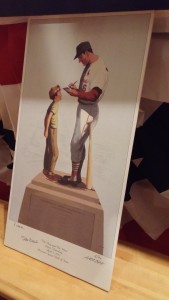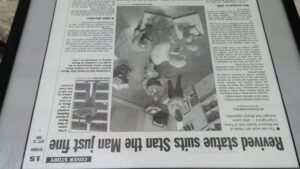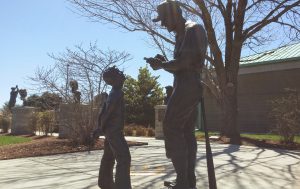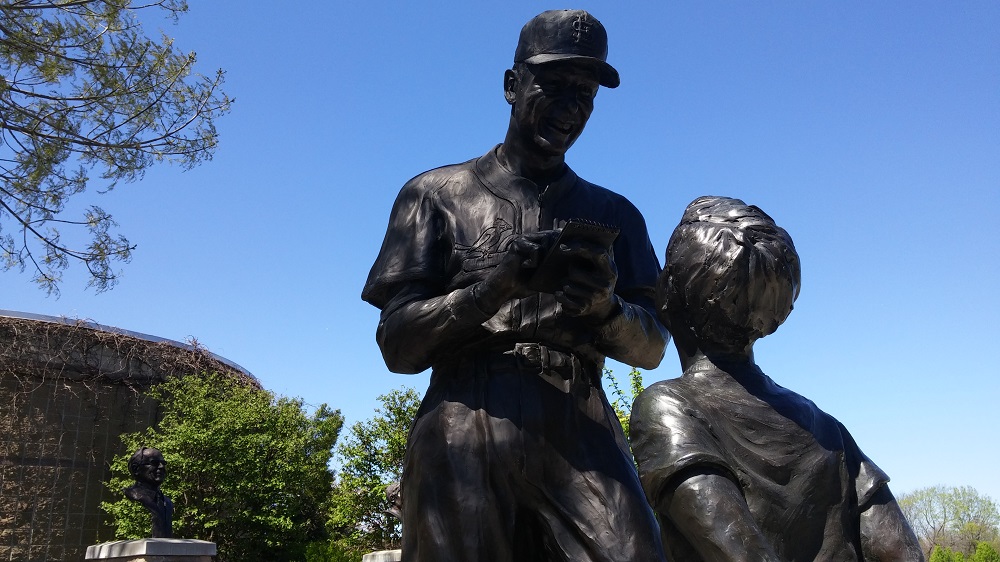
It has long served as a reminder of what sports can and should be. Of the star athlete never forgetting the fans. Of a child’s love for the game and his hero only growing.
“The Boy and The Man” life-size bronze statue – which depicts former St. Louis Cardinals great Stan “The Man” Musial signing an autograph for a young fan – arguably is one of the most powerful artistic pieces in sports.
Would you believe that this Thursday marks the 10th anniversary of its unveiling at the Missouri Sports Hall of Fame?
Dedicated on April 2, 2005 with Musial in attendance, the unveiling completed a 42-year effort initially designed on the canvas of a prominent St. Louis newspaper cartoonist.
Yet a number of twists and turns – including a substitute statue – shelved the idea until being dusted off years later by a Cardinals fan-turned-Hall president, Jerald Andrews.
And there it is now on the Legends Walkway.
Notice the scorecard Musial is signing in the bronze statue. It’s a change that came at the request of the Hall of Famer himself, after the original design called for a baseball, a costly item back in his playing days.
“I want to compliment the statue for this reason: Red Schoendienst and I back in St. Louis, we parked our cars across from the baseball field. On the weekends, a lot of out-of-town folks had their children at the game,” Musial told the crowd gathered along the Hall’s Legends Walkway that day. “Red Schoendienst and I would sign at least for two hours for youngsters. We took care of the youngsters. We loved the fans. We loved baseball. When I see all the kids out here today, I appreciate all their enthusiasm.”

That Musial was in attendance only raised the profile of what was a red-letter date in Ozarks sports history.
The Hall of Famer’s arrival marked his return to the city where, at age 19, his outfield career began in 1941 in the Class D Western Association.
It also came on a day when Springfield debuted its first Cardinals affiliate in 63 years and fielded a Minor League Baseball team for the first time since 1950, doing so at Hammons Field, the $32 million downtown ballpark built by Hall of Fame founder John Q. Hammons.
Musial threw out the ceremonial first pitch, and it is believed to be his last visit to Springfield before his passing in January 2013 at age 93.
Righting a wrong
What a day it was. To many, the Missouri Sports Hall of Fame statue not only won over Musial but also righted a perceived wrong, so to speak.
The statue on display is the original design by Amadee Wohlschlaeger, a cartoonist for the St. Louis Post-Dispatch whose work often walked across the sports page.
His idea first appeared in the Aug. 18, 1963 edition. A month later at Musial’s retirement at the ballpark, Cardinals owner Gussie Busch announced the statue would be a reality and would be sculpted from Wohlschlaeger’s rendering.
His Musial idea first appeared in the Aug. 18, 1963 edition and, a month later, Cardinals owner Gussie Busch announced on Musial’s retirement day that the ballpark would house the statue.
However, the “The Boy and the Man” never came to be, outside of old Busch Stadium anyway.
Sports writers, led by future Baseball Hall of Fame writer Bob Broeg of the Post-Dispatch, spread-headed a fundraising effort, yet fell $10,000 short of the $40,000 needed, according to a 2004 Post-Dispatch story.
At that point, the city stepped in as Mayor Raymond Tucker turned to Carl Mose, a professor of fine arts at Washington University. Years later, Musial publicly acknowledged that he was not a fan of Mose’s design.
“He’d make me bulky,” Musial told the Post-Dispatch in 2004. “I tried to get him to change it, but he just never would. So finally I told him, ‘Well, just go on and get it done.’ He never did it right.”
Said prominent sculptor Harry Weber, “I know Bob Broeg was appalled by it because of the phrase that went into the bottom of it was his idea.”
Weber is referring to the emblazoned words by then-Commissioner Ford Frick: “Here stands baseball’s perfect warrior. Here stands baseball’s perfect knight.
In steps the Hall

In 2004, almost 10 years into his term as President and Executive Director of the Missouri Sports Hall of Fame, Andrews revived the original design and led an ambitious fundraising effort. (The original rendering is in the St. Louis Cardinals Hall of Fame.)
The Hall purchased the rights from David Ault, who had purchased Wohlschlaeger’s art work some years earlier. At that point, Andrews commissioned Weber, who through 2014 has created 120 large statues and whose bronzes were featured in 16 states, 19 cities, 14 sports venues and three Halls of Fame.
Andrews’ fundraising effort hauled in more than $200,000.
“We raised a couple hundred thousand dollars and some through in-kind donations,” Andrews said. “Stan was in support of it.”
Among those proud to see the Musial statue come to fruition was Jerry Vickery, at the time the Missouri Sports Hall of Fame curator. When working for the St. Louis Cardinals in the late 1980s and 1990s, his efforts to breathe life into Wohlschlaeger’s design hit an apparent roadblock.
Vickery had written letters to potential supporters.
“Somehow my letters got to the Cardinals, and the president called me in and said, ‘We aren’t changing anything,’” Vickery said of then-Cardinals president Fred Kuhlmann. “That was 1991.”
More than a decade later, the project green-lighted a the Missouri Sports Hall of Fame, Vickery immediately went to work on staging the statue, after the Hall of Fame board agreed to extend the Legends Walkway beyond a life-size bronze of the late Payne Stewart.
Weber’s design

Musial’s support for the Missouri Sports Hall of Fame statue was so great that he visited Weber a few times during a nine-month construction, from clay to bronze.
The statue’s noticeable change came from a suggestion from Musial himself. Out went the baseball and inserted was a scorecard. He also requested changes to his chin and ankles.
“You’ve got me autographing. Back in those days, they didn’t have many balls being signed,” Musial was quoted as explaining to Weber, noting the balls were expensive to most families. “Most of the kids had pads or notebooks.”
The level of detail actually began from the start. Petroleum jelly prevented the clay from drying, a tactic Weber has used in his 30 years of bronzes. The sculpting itself covered two months, casting another month and setting the metal another couple of months.
“It was nice to have him come out,” Weber said. “And his wife liked it, which was probably the most important (opinion) at the time.
“I’m proud of it because it’s Stan,” Weber said. “I’ve done a couple of busts of Stan. But I particularly like this statue because of the message it proposes. It was about the fans. He never lost sight of that.”
